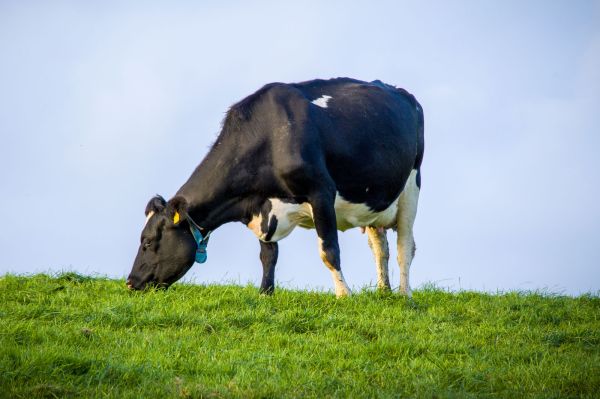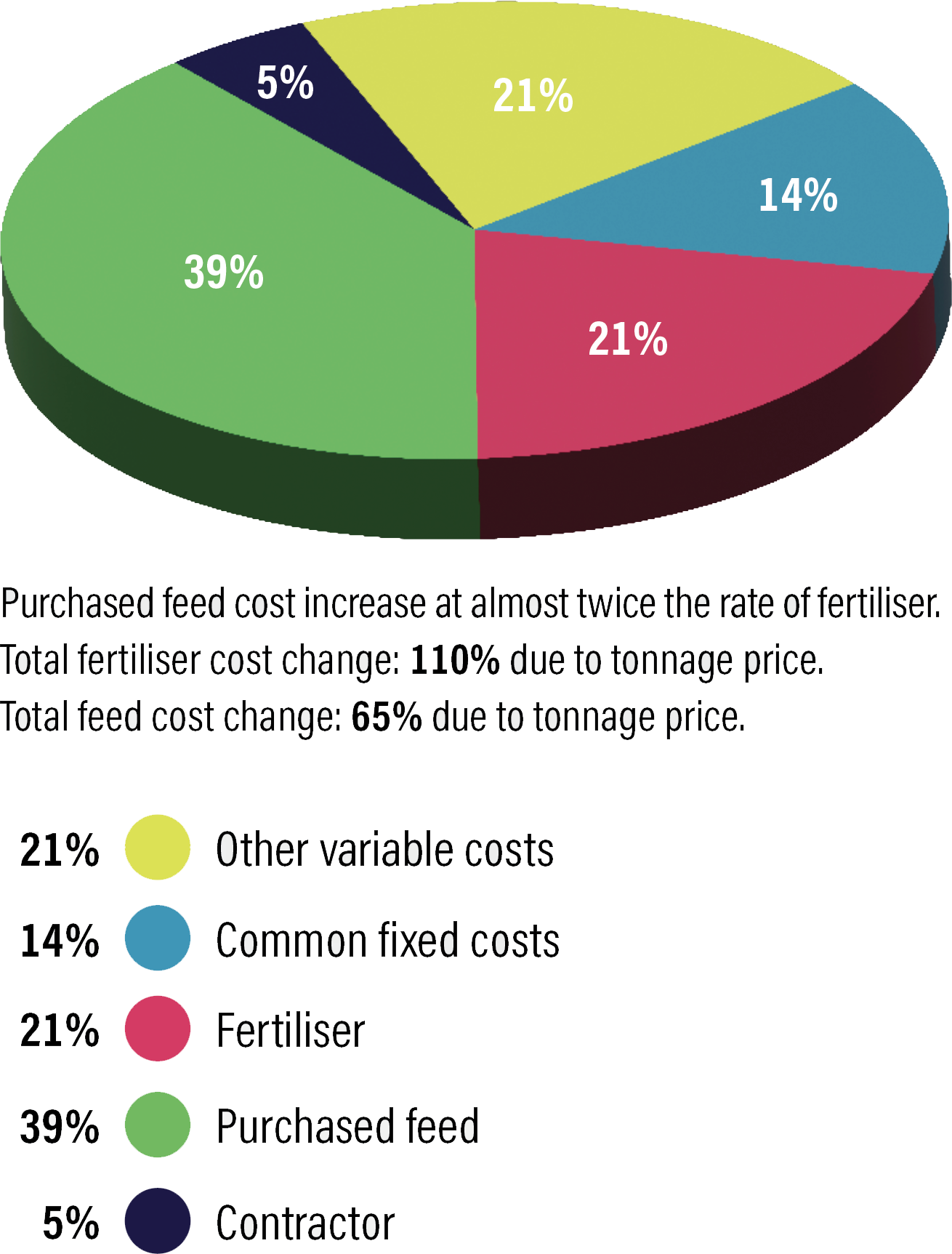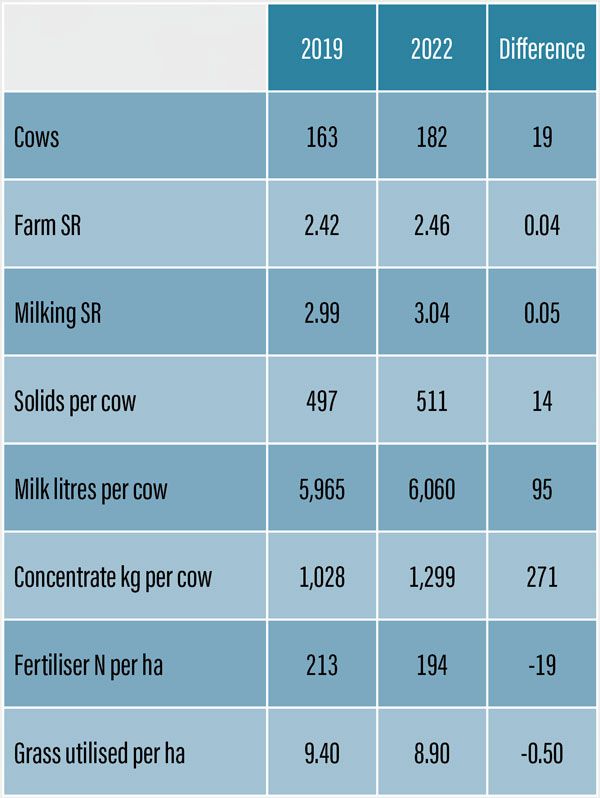System drift

It is clear that this is eroding competitiveness and profitability. Joe outlined the main aspects of this profit erosion and speculated at the driving forces around it. As well as presenting key trends in cost structure on Irish dairy farms, he highlighted the value of dairy cost benchmarking as a business development practice.
Milk price driver
One of the major questions to be answered is whether high milk prices in 2022 drove changes in inputs. The same question must be asked as to whether higher input prices also affected usage. Joe outlined the implications for profitability from changes in farm inputs and farmer reaction to milk prices.
The Teagasc dairy head used a selection of dairy farms, with analysis gleaned from the Teagasc Profit Monitor database, to explore and confirm the key trends in terms of management practices being pursued over time. Using the data he showed worrying changes in costs, inputs and efficiency that suggest a trend towards higher cost and lower profitability over an extended period of five years. To ensure his findings were accurate and targeted, Joe analysed data from one hundred specialist dairy farms over several years. Larger scale and higher intensity specialist dairy farms were chosen, with labour costs and land lease charges excluded from common input costs, so that viable comparisons could be made without the distortions associated with individual farm circumstances.
While it should be noted that this multi-year dairy farm financial analysis included the extremely disruptive input cost surge associated with the Ukrainian invasion, the long-term trends are still valid. The main findings were that purchased feed costs increased at almost twice the rate of fertiliser, while total fertiliser cost changed by 110 per cent due to tonnage price. By comparison, the total feed cost change was influenced by 65 per cent due to tonnage price. That immediately points to a significant increase in feed input volumes.
Pasture utilisation linked to margin
Joe stood back and looked at the fundamentals of profitable dairy farming. His absolute contention is that pasture utilised has a strong positive relationship to margin per hectare. That, he insists, is a consistent fact across years with very different price/cost bases.
On the other side of the equation, Joe pointed out that milk yields (or solids) have a weak relationship to margin per hectare, with a moderate to weak relationship to margin per cow. Again, his conclusions are that these equations are maintained over the longer term, with no effect from either milk price or input cost variations.
This moderate to weak relationship of profitability with solids per cow is a core principle of dairy profitability. Ultimately, he said, increased concentrate feeding rate in 2022 gave negligible milk response. An associated observation was whether the increased concentrate feeding was compensating for changes in farm forage budgets. In other words, whether less grass was being grown and/or utilised on farms. The Teagasc speaker emphasised the strong relationship between cost per litre and margin per hectare and warned that discipline on cost control is not a ‘low milk price year’ activity.
The dairy farm finances analysed by Joe showed that farmers did respond pragmatically to high fertiliser price by reducing application rates by 10 per cent. Did this, in turn, lead to lower forage grown with the necessity then to compensate by increasing concentrate feed input volumes? There are clear contradictions in farmer reaction to higher input costs, from the input analysis. For instance, while higher fertiliser prices were seen to drive down fertiliser inputs on farms, the same action was not seen in how farmers reacted to higher concentrate prices. Was there some other vector acting in the background, to some extent or other? Weather conditions, for instance? Periodic droughts are becoming increasingly common and farmers, in at least some instances, may decide to curtail fertiliser applications when there is evidence that there is no grass growth benefit. On the other side of that equation, farmers might increase concentrate inputs during those forage deficit periods. That observation, however, does not fully explain the Teagasc analysis of longer-term trends that flatten out occasional fertiliser/concentrate changes on farms due to climatic conditions.

Analysis of change in costs.
Proportion of change in common costs per cow 2019-22
A false premise?
Ultimately, the question must be asked as to whether farmers consider, inaccurately, that concentrates offer a better return on investment than fertiliser. That would seem to be the rational explanation if only because, as Joe points out, increased concentrate price did not lead to a reduction in concentrate usage, while it seems that higher fertiliser prices did provoke a reduction in volumes applied. The substitution of one input (fertiliser) for another (concentrate) is a rational response to input cost changes, provided it makes economic sense. Joe is adamant that this particular response does not make sound economic sense. Examining 2022 high milk prices, Joe considered whether those high milk prices were the stimulant to feed extra concentrate for marginal response. If so, he is clear that there is little or no economic value in that decision. The average response, Joe points out, was 0.35kg milk/kg additional concentrate. Even at high milk prices, the figures do not add up, he concludes. Without the deep analysis that Joe was able to undertake, it is easy to see how high milk price may have masked the lack of economic response to additional feeding.

Change in feed budget metrics.
A clear message
Joe was unambiguous in his messaging around the drivers of profitability on Irish dairy farms: “Pasture utilisation is a key driver of dairy farm profit per hectare. However, pasture utilisation declined by 0.5t DM per hectare across farms in 2022. That points towards less focus on grass growth with increased feed supplement rate for little change in milk output. The record profits in 2022 were driven by milk price increases, not by efficiency gains.” He added that cost per litre is strongly linked to margin per hectare and advised that it is essential to maintain cost control focus, independent of changes to milk price.




